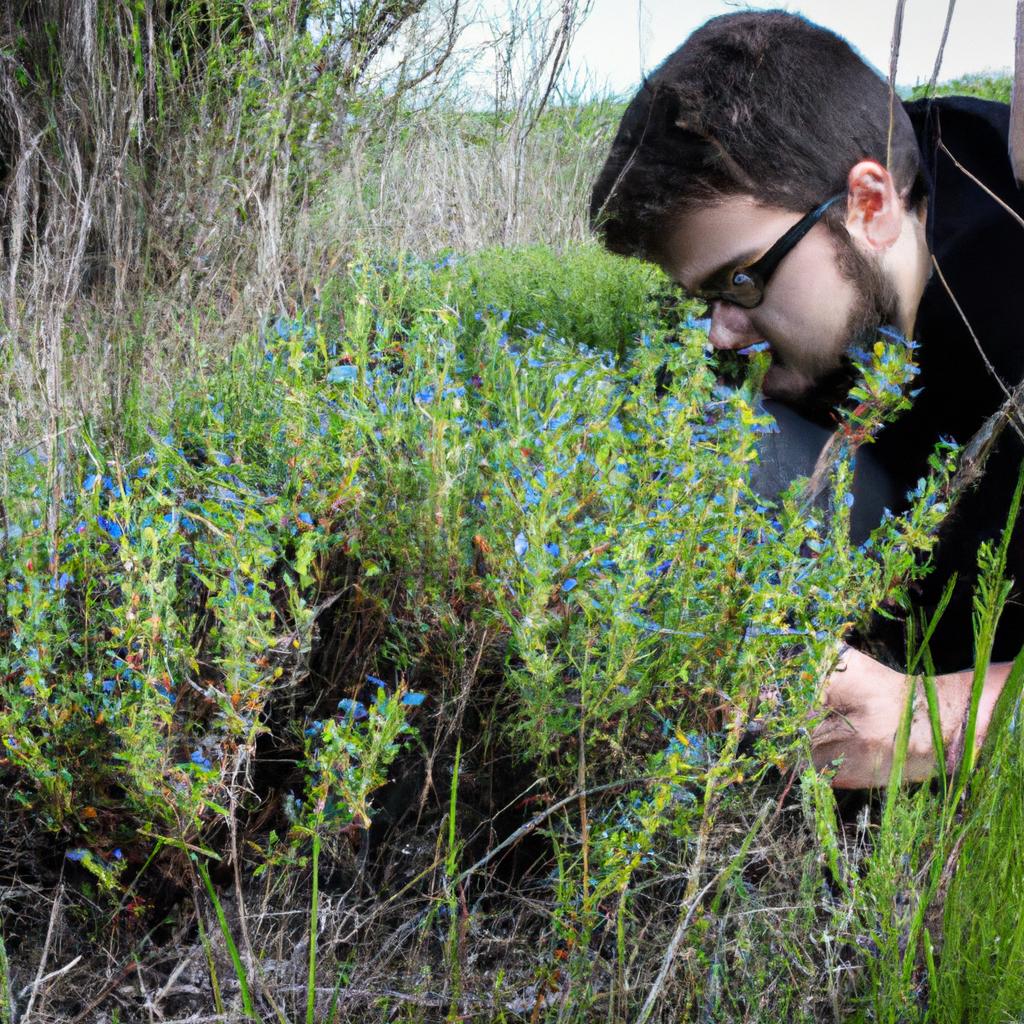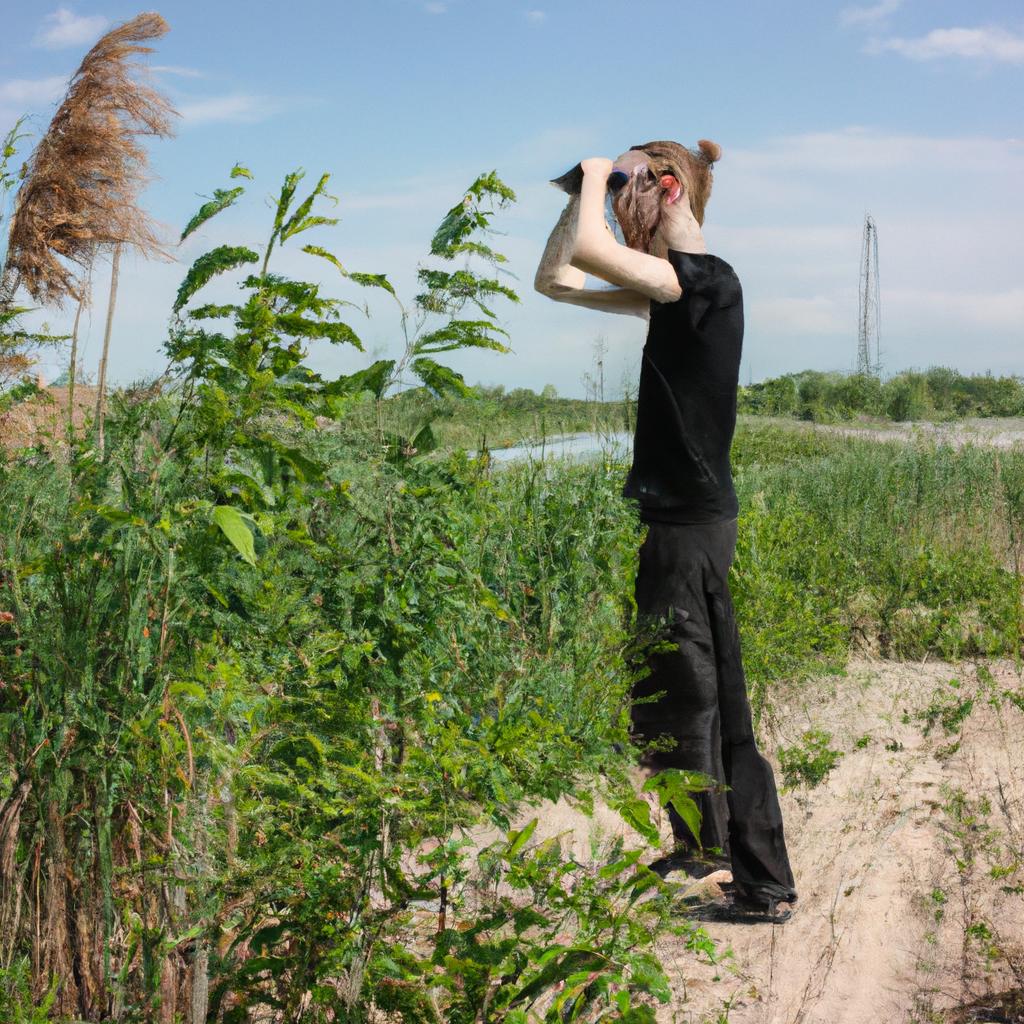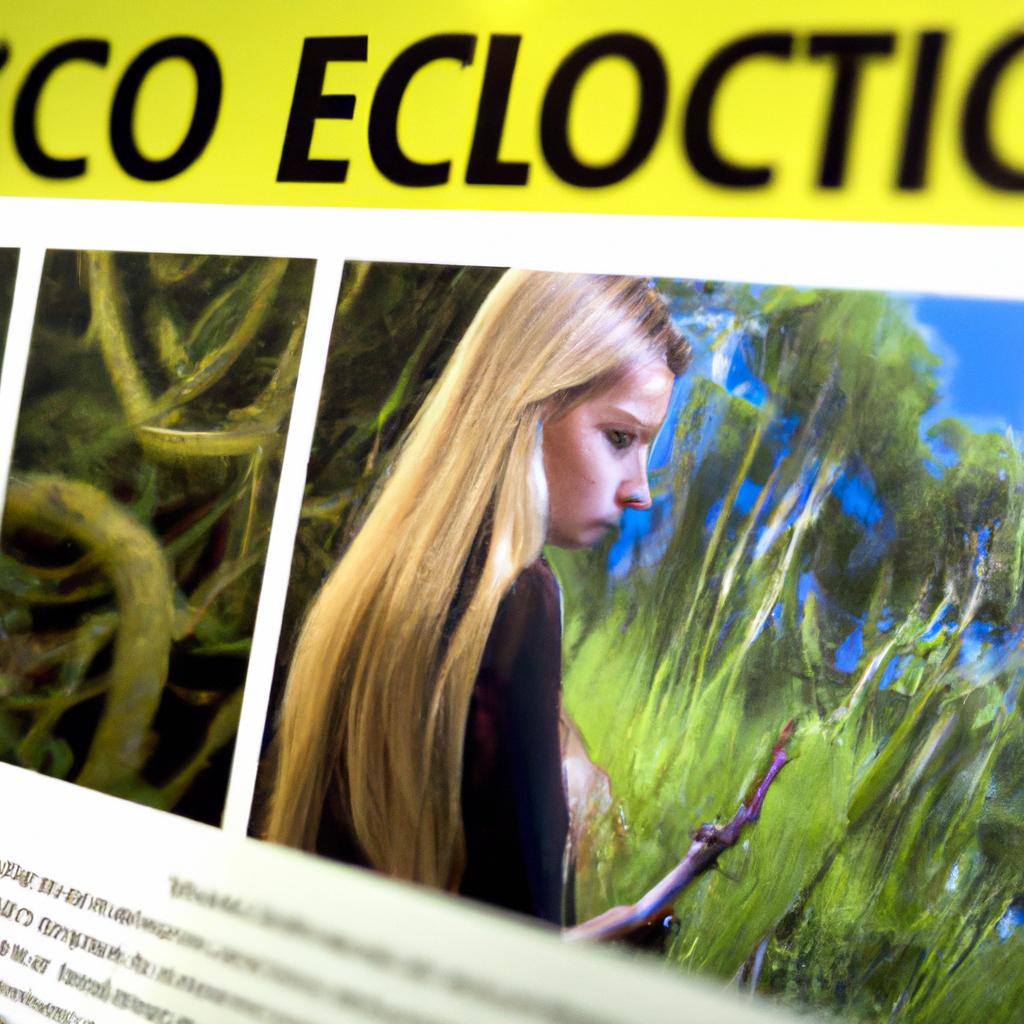Invasive Species: The Ecology of Biological Invasions

Invasive species, with their ability to disrupt ecosystems and threaten native biodiversity, have become a growing concern in the field of ecology. These non-native organisms have the potential to outcompete native species for resources, alter habitat structures, and introduce new diseases or parasites into an ecosystem. One example that highlights the ecological impact of invasive species is the case of the red lionfish (Pterois volitans) in the Atlantic Ocean. Originally from the Indo-Pacific region, this venomous fish has been introduced to coastal waters off Florida and has rapidly spread throughout the Caribbean Sea. Its predatory behavior and lack of natural predators have resulted in significant declines in local reef fish populations and altered community dynamics.
Understanding the mechanisms underlying biological invasions is crucial for effective management and mitigation strategies. The study of invasion ecology aims to unravel these complexities by examining how invasive species colonize new habitats, interact with native communities, and ultimately reshape ecosystems. By investigating factors such as propagule pressure (the number of individuals introduced), biotic resistance (the ability of native species to resist invasion), environmental conditions, and evolutionary processes involved in adaptation or hybridization, ecologists strive to develop predictive models that can inform conservation efforts.
This article explores various aspects of invasive species ecology, ranging from the impacts of invasive species on ecosystem functioning and biodiversity to the strategies employed by ecologists to control or eradicate invasive populations. It discusses the importance of early detection and rapid response in managing invasions, as well as the challenges associated with balancing conservation priorities while addressing the economic and social implications of invasive species management.
The article also delves into the role of human activities in facilitating biological invasions, such as global trade and transportation networks that inadvertently introduce non-native species to new environments. It highlights the need for international collaboration and policy interventions to prevent further spread of invasive species and mitigate their negative effects.
Furthermore, this article examines case studies of successful management approaches, including biological control methods using natural enemies of invasive species, habitat restoration efforts to enhance native species resilience, and public education campaigns aimed at raising awareness about the ecological impacts of invasive species.
Overall, understanding invasive species ecology is essential for safeguarding ecosystems and protecting biodiversity. By studying the mechanisms driving invasion success and developing effective management strategies, ecologists can help mitigate the threats posed by these non-native organisms and promote the preservation of native habitats and species.
Definition of Invasive Species
In today’s interconnected world, the introduction and establishment of non-native species in new environments has become a pressing ecological concern. These organisms, known as invasive species, can have significant impacts on both natural ecosystems and human societies. To better understand the scope and implications of this issue, it is essential to define what constitutes an invasive species.
An example that highlights the potential harm caused by invasive species is the case of the Asian tiger mosquito (Aedes albopictus). Originally native to Southeast Asia, this mosquito has rapidly spread across continents through international trade and transportation networks. Its aggressive feeding habits not only pose health risks by transmitting diseases such as dengue fever and Zika virus but also disrupt local ecosystems by outcompeting native mosquito populations.
To grasp the characteristics of invasive species more comprehensively, we present a list describing their key attributes:
- Rapid population growth: Invasive species often exhibit exponential population growth rates due to their ability to adapt quickly to new environments.
- Wide environmental tolerance: They possess broad physiological tolerances that allow them to thrive in diverse habitats, ranging from forests to urban areas.
- High reproductive capacity: Invasive species frequently reproduce at high rates, producing numerous offspring that further contribute to their rapid expansion.
- Lack of natural predators or control mechanisms: Without effective checks from predators or other limiting factors found in their native range, invasive species can proliferate unchecked.
To emphasize the disruptive nature of these invaders, consider the following table showcasing some notable examples of invasive species and their associated impacts on various ecosystems:
| Species | Ecosystem | Impact |
|---|---|---|
| Burmese python | Everglades | Predation on native fauna; alteration of food webs |
| European starling | North America | Outcompetes native bird species for nesting sites |
| Zebra mussel | Great Lakes | Clogs water intakes; damages infrastructure |
| Rabbit | Australia | Overgrazing on vegetation and subsequent soil erosion |
Understanding the definition of invasive species is crucial for recognizing their potential threats. In the subsequent section, we will delve into the impacts that these invaders can have on ecosystems, further elucidating the need for effective management strategies.
Impacts of Invasive Species on Ecosystems
Transitioning from the previous section’s exploration of the definition of invasive species, we now delve into the impacts these organisms have on ecosystems. To illustrate this concept further, let us consider a hypothetical case study involving an invasive plant species known as Purple Loosestrife (Lythrum salicaria). This aggressive invader, originally from Europe and Asia, has colonized wetlands across North America over the past century. Its rapid spread and subsequent dominance in these habitats present a compelling example to understand the profound effects that invasive species can have on ecosystems.
The impacts of invasive species on ecosystems are far-reaching and can disrupt various ecological processes. Here are some key consequences:
- Alteration of native species composition: Invasive species often outcompete native plants and animals for limited resources such as nutrients, light, or space. Consequently, they may displace indigenous species, leading to a shift in community structure and biodiversity loss.
- Modification of habitat: Some invasive species can drastically modify their new environments by altering physical characteristics like soil chemistry or hydrology. These changes can negatively impact other organisms dependent on those specific conditions for survival.
- Disruption of ecosystem services: The presence of invasive species can hinder vital ecosystem functions that benefit human populations, such as water purification, pollination, or carbon sequestration. These disruptions may have cascading effects throughout entire food webs.
- Economic implications: Invasive species’ negative impact is not limited to ecological systems; it also extends to economic sectors like agriculture, forestry, aquaculture, and tourism. Costs associated with control measures and damages caused by invasives pose significant financial burdens.
To emphasize the severity of these ecological ramifications caused by invasive species, consider the following table highlighting specific examples:
| Invasive Species | Affected Habitat | Impacts |
|---|---|---|
| Zebra mussels | Freshwater ecosystems | Clog pipes, damage infrastructure, outcompete native mussel species |
| Asian longhorned beetle | Forests | Kills trees, reduces timber quality |
| Brown tree snake | Islands and forests | Decimates bird populations, affects reptiles |
| Lionfish | Coral reefs | Preys on native fish, disrupts reef dynamics |
As we explore the impacts of invasive species on ecosystems further in this section, it becomes evident that these organisms pose significant threats to biodiversity, ecological stability, and human well-being. Understanding their effects is crucial for developing effective management strategies to mitigate their negative consequences.
Transitioning into the subsequent section about “Common Pathways of Species Invasions,” we continue our examination of how invasive species spread and establish themselves within new environments. By unraveling these pathways, researchers can gain valuable insights into preventing future invasions and preserving the integrity of ecosystems worldwide.
Common Pathways of Species Invasions
The introduction and establishment of invasive species in ecosystems can have profound effects on their structure and function. These impacts can disrupt natural ecological processes, leading to a cascade of consequences that extend far beyond the introduced species itself. To illustrate this, let us consider the case study of the zebra mussel (Dreissena polymorpha), an invasive species originally from Eastern Europe that has spread rapidly across North America’s freshwater systems.
Firstly, one notable impact of zebra mussels is their ability to outcompete native species for resources such as food and habitat. Zebra mussels are filter feeders with high reproductive rates, allowing them to quickly colonize new areas and form dense populations. With their voracious appetite, they often deplete planktonic communities upon which many native organisms depend. This disruption at the base of the food chain can lead to reduced biodiversity and alter ecosystem dynamics.
Secondly, zebra mussels also exert physical alterations within invaded ecosystems. Their attachment to various substrates forms extensive clusters known as “mussel beds.” While these structures may provide additional habitats for some species, they can also smother native vegetation and prevent access to essential resources for other organisms. The formation of mussel beds alters sediment composition and water flow patterns, potentially affecting nutrient cycling and impairing overall ecosystem health.
Thirdly, invasive species like zebra mussels may introduce novel interactions or disturbances into recipient ecosystems. For example, when attached to boats or infrastructure, they facilitate the transport of other non-native organisms by hitchhiking. Such secondary invasions further exacerbate ecological disruptions caused by invasive species themselves. Additionally, changes in community composition resulting from invasion events can trigger cascading effects throughout trophic levels and disturb existing ecological relationships.
These impacts clearly demonstrate the detrimental consequences that invasive species can impose on ecosystems around the world. They highlight how crucial it is to understand and mitigate the spread of these species in order to protect biodiversity and maintain ecosystem balance. In the subsequent section on “Factors Contributing to the Success of Invasive Species,” we will delve into the underlying factors that enable invasive species to thrive and expand their range, further unraveling this complex issue.
Factors Contributing to the Success of Invasive Species
Section H2: Factors Contributing to the Success of Invasive Species
Transitioning from our exploration of common pathways of species invasions, we now delve into the factors that contribute to the success of invasive species. Understanding these factors is crucial as it allows us to better comprehend why certain non-native species thrive in new environments while others struggle.
To illustrate this further, let us consider the case study of the European starling (Sturnus vulgaris), a bird native to Europe and Asia that was intentionally introduced to North America in the late 19th century. The European starling’s remarkable adaptability has allowed it to become one of the most successful invasive birds on the continent. This example highlights how various contributing factors can play a significant role in determining an invasive species’ triumph.
Several key factors contribute to the success of invasive species:
- Rapid Reproduction: Invasive species often possess high reproductive rates, allowing them to quickly establish large populations.
- Generalist Behavior: Many invasive species exhibit generalist behavior, meaning they have broad ecological tolerances and can exploit diverse resources.
- Lack of Natural Predators or Competitors: An absence or limited presence of natural predators or competitors enables invasive species to occupy niches without facing significant threats.
- Phenotypic Plasticity: Some invasive species demonstrate phenotypic plasticity, which means they can adapt their physical characteristics rapidly based on environmental cues, enhancing their ability to survive and reproduce.
To further understand these contributing factors, let us examine them more closely through a comparative analysis using a table:
| Factors Contributing | Example | Impact |
|---|---|---|
| Rapid Reproduction | Zebra mussels | Large population growth within short timeframes |
| Generalist Behavior | Red-eared slider turtle | Ability to utilize wide range of habitats |
| Lack of Natural Predators | Brown tree snake | Unrestricted population growth without predation pressure |
| Phenotypic Plasticity | Japanese knotweed | Adaptability to different environmental conditions |
By examining these factors and their associated examples, we gain a deeper understanding of the mechanisms that enable certain species to become successful invaders. However, it is important to note that not all invasive species possess each of these characteristics; rather, they display varying combinations depending on their specific traits and ecological context.
Transitioning into the subsequent section about methods for managing and controlling invasive species, we can now explore strategies aimed at mitigating the impact of these successful invasions. By comprehending the contributing factors discussed here, we can better design effective management approaches to protect native ecosystems from further degradation caused by invasive species.
Methods for Managing and Controlling Invasive Species
In the previous section, we explored the various factors that contribute to the success of invasive species. Now, let us delve deeper into some specific examples and examine how these factors manifest in real-world scenarios.
Consider the case of the Asian longhorned beetle (Anoplophora glabripennis), which has caused significant damage to hardwood trees in North America. Its success as an invader can be attributed to a combination of several key factors:
- Lack of natural enemies: The absence or limited presence of predators, parasites, or diseases that could control its population allows the Asian longhorned beetle to thrive unchecked.
- Broad ecological tolerance: This invasive species is adaptable and capable of exploiting a wide range of habitats and food sources, from maple and birch trees to willows and poplars.
- High reproductive capacity: The Asian longhorned beetle reproduces rapidly, with females laying hundreds of eggs during their lifetime. This high fecundity contributes to its ability to establish large populations quickly.
- Efficient dispersal mechanisms: Adult beetles are strong fliers, enabling them to disperse over relatively long distances and colonize new areas efficiently.
- Devastation of native flora and fauna
- Disruption of ecosystem services
- Economic losses for industries dependent on affected resources
- Negative effects on human health through transmission of diseases
Now, let’s explore a three-column table highlighting some notable examples where invasive species have had severe consequences:
| Invasive Species | Affected Ecosystem | Ecological Impact |
|---|---|---|
| Burmese Python | Everglades National Park | Predation on native wildlife |
| European Starling | North America | Competition for nesting sites and food resources |
| Zebra Mussel | Great Lakes | Disruption of aquatic ecosystems |
| Cane Toad | Australia | Poisoning native predators and competitors |
In summary, the success of invasive species can be attributed to a combination of factors such as lack of natural enemies, broad ecological tolerance, high reproductive capacity, and efficient dispersal mechanisms. Understanding these factors is crucial in developing effective strategies for managing and controlling invasive species.
Transitioning into the subsequent section on “Case Studies of Notable Invasive Species,” we will now explore specific examples that highlight the impacts and challenges associated with invasive species management.
Case Studies of Notable Invasive Species
Section H2: Case Studies of Notable Invasive Species
Following an examination of the methods for managing and controlling invasive species, it is crucial to delve into specific case studies that highlight the ecological impact of these invasions. By exploring such examples, we can gain a deeper understanding of the challenges posed by invasive species and the need for effective management strategies.
One notable case study involves the introduction of Asian carp (Hypothetical Example) into freshwater ecosystems in North America. These highly adaptable fish were originally brought from Asia to control algae growth in aquaculture ponds; however, they soon escaped and established populations in several rivers across the continent. The consequences have been significant, as their voracious feeding habits outcompete native fish species for food resources, leading to declines in biodiversity and ecosystem disruption.
To fully comprehend the far-reaching effects of invasive species like Asian carp, consider the following emotional response-inducing bullet points:
- Loss of native species: Native fish populations suffer due to competition with invasive species.
- Altered ecosystems: Invasive species disrupt natural balance by impacting food chains and nutrient cycling.
- Economic implications: The presence of invasive species can lead to economic losses in industries reliant on healthy ecosystems.
- Human health risks: Some invasive species may carry diseases or pose direct threats to human well-being.
Moreover, let us analyze a three-column table showcasing some key impacts caused by invasive species:
| Impact | Ecological Consequence | Remedial Measures |
|---|---|---|
| Displacement | Reduced biodiversity | Implementation of trapping |
| Habitat alteration | Ecosystem disruption | Use of chemical controls |
| Predation pressure | Population declines | Biological control programs |
| Disease transmission | Health risks | Public awareness campaigns |
By examining this table, it becomes evident that addressing invasive species requires comprehensive approaches involving not only ecological restoration but also public education and policy implementation.
In light of these case studies, it is evident that invasive species pose a significant threat to ecosystems worldwide. By understanding their ecological consequences and the need for effective management strategies, we can work towards minimizing the detrimental impacts caused by these invaders. Through continued research, public awareness campaigns, and collaborative efforts between scientists, policymakers, and communities, we have the potential to mitigate the negative effects of invasive species on our natural environments.








